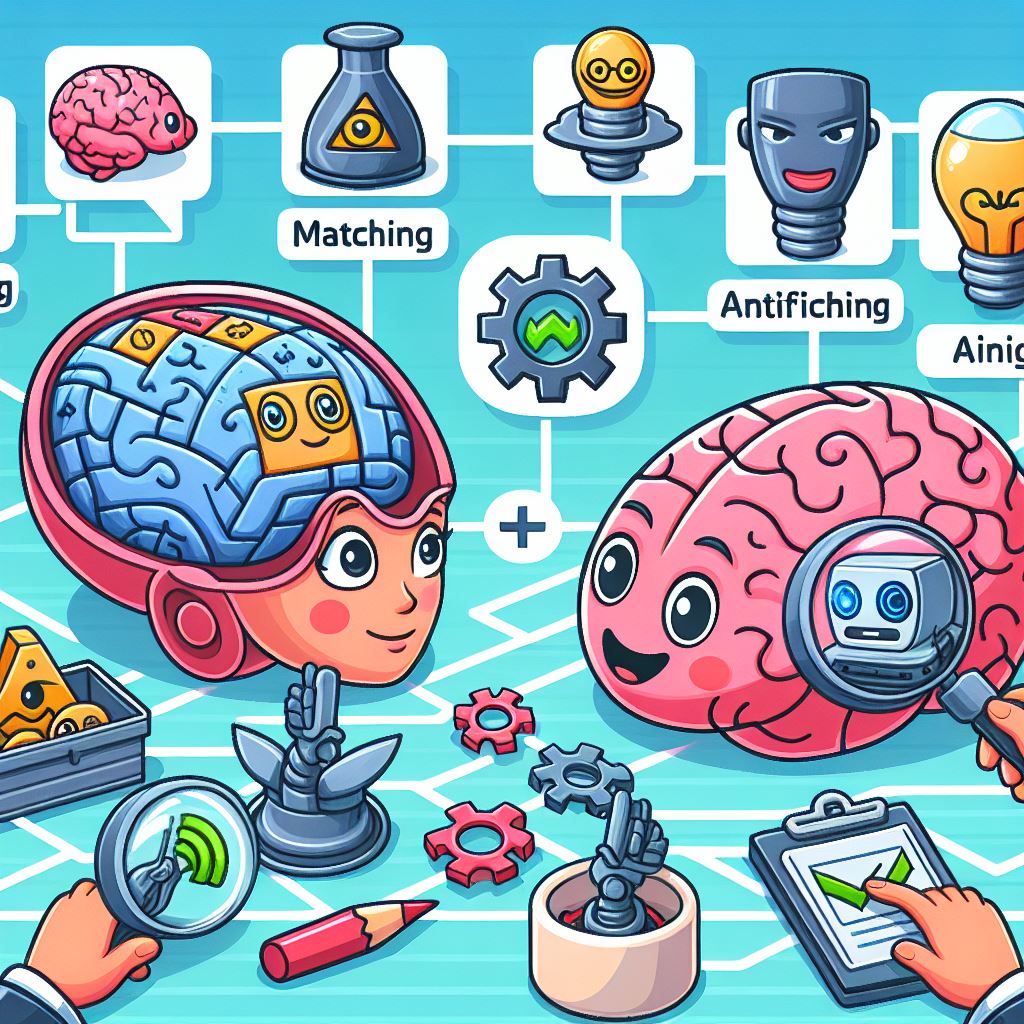Estimated reading time: 8 mins
In the world of data processing and natural language understanding, fuzzy matching algorithms have long been the cornerstone for tasks involving text comparison, data deduplication, and entity resolution. However, with the advent of advanced AI models like OpenAI’s ChatGPT, there’s a paradigm shift in how these tasks can be approached. In this post, we’ll explore how ChatGPT can be used to replace complex fuzzy matching algorithms, offering a more intuitive and efficient solution.

Understanding Fuzzy Matching
Fuzzy matching, at its core, is a process that identifies non-exact matches in text data. Traditional algorithms like Levenshtein distance, Jaccard similarity, or cosine similarity measure how closely text strings resemble each other. This process is crucial in scenarios like detecting duplicate records in databases where discrepancies due to typos, abbreviations, or different data entry formats occur.
Limitations of Traditional Fuzzy Matching
While effective, these algorithms have limitations. They often require extensive fine-tuning, struggle with linguistic nuances, and can be computationally intensive, especially with large datasets. It’s important to understand that while they have been invaluable in many applications, their effectiveness can be hindered by several factors:
- Literal Matching Constraints: Traditional algorithms, like the Levenshtein distance, are primarily designed for literal character-by-character comparison. They excel at identifying small differences between strings (like typos), but they lack the ability to understand context or meaning. This means they might fail to recognize matches in cases where paraphrasing or significant rewording occurs, despite the underlying meaning being similar.
- Handling of Language Nuances: Languages are rich and complex, often involving synonyms, idioms, and varied sentence structures. Traditional fuzzy matching algorithms struggle to capture these nuances. They typically do not account for the semantics of the language, leading to mismatches or missed connections where a human reader would easily see a connection.
- Sensitivity to Data Quality: The accuracy of these algorithms is heavily dependent on the quality of the input data. Issues like spelling errors, inconsistent use of abbreviations, or varying data entry formats can significantly affect their performance. While this is true for most data processing systems, traditional fuzzy matching algorithms are particularly sensitive to these issues due to their reliance on literal string similarity.
- Scalability Challenges: When dealing with large datasets, the computational complexity of fuzzy matching algorithms can become a bottleneck. Many of these algorithms have a time complexity that increases significantly with the length of the strings being compared, making them less efficient for large-scale applications.
- Difficulty in Tuning and Optimization: Finding the right balance between precision and recall is a significant challenge with traditional fuzzy matching algorithms. Adjusting parameters to fine-tune these algorithms for specific contexts often requires deep technical understanding and can be time-consuming. This process can be particularly challenging when dealing with diverse datasets where the optimal settings may vary significantly across different segments of the data.
- Inadequate for Complex Matching Scenarios: In cases where the matching criteria are complex and go beyond simple string similarity (such as matching based on contextual relevance or thematic similarity), traditional algorithms fall short. They are not equipped to understand the broader context or the specific content of the texts, limiting their usefulness in more sophisticated text analysis tasks.
- Lack of Adaptability: Traditional algorithms do not learn from new data or evolve over time. In a dynamic world where language use and data patterns constantly change, the static nature of these algorithms means they can quickly become outdated, requiring manual intervention to update or reconfigure them.
In contrast, AI-based models like ChatGPT offer a more dynamic and context-aware approach, addressing many of these limitations by understanding the semantics and intent behind text, leading to more accurate and efficient text matching in a variety of applications.
Enter ChatGPT: A New Era of Text Matching
ChatGPT, a variant of the GPT (Generative Pretrained Transformer) models, revolutionizes text matching by leveraging deep learning. It understands and generates human-like text, making it capable of handling fuzzy matching tasks with a more nuanced understanding of language.
How ChatGPT Transforms Text Matching
- Contextual Understanding: Unlike traditional algorithms that work at a character or word level, ChatGPT grasps the context and semantics of the text. This means it can effectively handle synonyms, paraphrases, and varied sentence structures.
- Handling Ambiguity: ChatGPT’s strength lies in its ability to deal with ambiguities in human language, something that traditional fuzzy matching algorithms often struggle with.
- Scalability and Efficiency: Powered by deep learning, ChatGPT can process large volumes of data efficiently, making it suitable for big data applications.
Real-World Applications
- Data Deduplication: In CRM systems, ChatGPT can identify duplicate customer records even if the data entries are not exactly the same.
- Content Moderation: It can help in detecting similar but not identical inappropriate content by understanding the context and nuances of the language.
- Customer Support: ChatGPT can match customer queries with relevant answers from a knowledge base, even if the wording of the queries varies.
Implementing ChatGPT for Fuzzy Matching
Let’s delve into how you can practically implement ChatGPT for tasks typically reserved for fuzzy matching algorithms.
Step 1: Define the Task
Clearly define what you want to achieve. Are you looking to identify duplicates in a dataset, match similar customer queries, or something else? The application will dictate how you interact with ChatGPT.
Step 2: Preparing Your Data
Ensure your data is clean and organized. While ChatGPT is robust in handling various data formats, cleaner data usually yields better results.
Step 3: Fine-Tuning ChatGPT (Optional)
For specific applications, you might consider fine-tuning ChatGPT on a dataset that is representative of your task. This can enhance its ability to understand domain-specific language and nuances.
Step 4: Integration and Interaction
Integrate ChatGPT into your system. You can use OpenAI’s API to send text inputs to ChatGPT and receive responses. The interaction could be as simple as sending a pair of strings to compare and receiving an assessment of their similarity.
Step 5: Post-Processing the Output
In some cases, you might need to post-process ChatGPT’s output for your specific needs, like converting its response into a similarity score.
Best Practices and Considerations
- Continuous Learning: Regularly update the model with new data to maintain its effectiveness.
- Ethical Considerations: Be aware of and mitigate any biases in the model, especially when dealing with sensitive data.
- Performance Monitoring: Continuously monitor the performance and accuracy of the model in your specific application.
Comparing ChatGPT with Traditional Algorithms
To illustrate the effectiveness of ChatGPT in fuzzy matching tasks, let’s compare it with a traditional algorithm like the Levenshtein distance.
Case Study: Matching Customer Queries
Imagine a scenario where you need to match customer support queries to a set of predefined answers.
- Traditional Approach (Levenshtein Distance): This method would involve calculating the edit distance between each query and the predefined answers. It’s effective for catching minor typos or variations in phrasing but falls short with paraphrased queries or those with different structures.
- ChatGPT Approach: When the same task is approached with ChatGPT, the model understands the intent and context behind each query. It can match a query like “How do I reset my password?” with a paraphrased answer in the knowledge base like “Steps to change your password.”


Scenario with Prompt Example
Here’s an example where we will use ChatGPT to handle a fuzzy matching task typically suited for a traditional algorithm. We’ll look at a customer support scenario where the goal is to match customer queries to a set of predefined answers.
Example Prompt for ChatGPT:
Prompt: “I have two datasets. Dataset A contains customer queries, and Dataset B contains predefined answers. Can you match each query in Dataset A to the most relevant answer in Dataset B, even if the wording is not exactly the same?”
Example Datasets:
Dataset A: Customer Queries
- “How do I change my account password?”
- “Is there a way to track my order?”
- “Can I return a product after 30 days?”
- “Methods to update billing information?”
- “Trouble signing into my account.”
Dataset B: Predefined Answers
- “To reset your password, go to the settings page and select ‘Change Password.'”
- “Order tracking is available under the ‘My Orders’ section in your account.”
- “Products can be returned within a 30-day period following the purchase date.”
- “Update your billing information by navigating to ‘Account Settings’ and selecting ‘Billing.'”
- “If you’re experiencing issues logging in, ensure your credentials are correct or try resetting your password.”
Using ChatGPT for Matching:
You would send each query from Dataset A to ChatGPT, asking it to find the most relevant answer from Dataset B. For instance, for the first query “How do I change my account password?”, ChatGPT might analyze the context and meaning behind the query and match it to the first answer in Dataset B, as it talks about resetting a password, which is essentially what the query is about.
Expected Matching Output:
- “How do I change my account password?” matches with “To reset your password, go to the settings page and select ‘Change Password.'”
- “Is there a way to track my order?” matches with “Order tracking is available under the ‘My Orders’ section in your account.”
- “Can I return a product after 30 days?” matches with “Products can be returned within a 30-day period following the purchase date.”
- “Methods to update billing information?” matches with “Update your billing information by navigating to ‘Account Settings’ and selecting ‘Billing.'”
- “Trouble signing into my account.” matches with “If you’re experiencing issues logging in, ensure your credentials are correct or try resetting your password.”
This example demonstrates how ChatGPT can understand and match based on the meaning and intent behind phrases, rather than relying solely on keyword matching or string similarity metrics. It is far more reliable because it uses the intent and meaning of the texts rather than the word representation.
Conclusion
ChatGPT presents a paradigm shift in handling tasks traditionally reserved for fuzzy matching algorithms. Its understanding of context, ability to process large volumes of data, and adaptability to various applications make it a powerful tool in the data processing arsenal. While it may not completely replace traditional algorithms in every scenario, it certainly opens up new possibilities for handling complex text matching tasks with greater efficiency and accuracy.
Embracing ChatGPT for fuzzy matching tasks is not just about leveraging new technology; it’s about rethinking our approach to handling the complexities of human language in data. As we move forward, the synergy of traditional algorithms and AI models like ChatGPT will likely shape the future of text analysis and data management.
